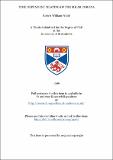Files in this item
Time dependent heating of the solar corona
Item metadata
| dc.contributor.advisor | Bell, Graham S. | |
| dc.contributor.advisor | Hood, Alan W. | |
| dc.contributor.author | Walsh, Robert William | |
| dc.coverage.spatial | 151 p. | en_US |
| dc.date.accessioned | 2018-06-19T14:10:56Z | |
| dc.date.available | 2018-06-19T14:10:56Z | |
| dc.date.issued | 1996 | |
| dc.identifier.uri | https://hdl.handle.net/10023/14267 | |
| dc.description.abstract | The problem of how the Sun's corona is heated is of central importance in Solar Physics research. In this thesis, a model is constructed of a typical coronal magnetic loop in order to investigate the response of coronal plasma to a time-dependent heating source. It is not the aim of the research to study in detail a particular heating mechanism but rather to understand the important features arising from time-dependent heating in general. A time-varying energy input into the coronal loop is required because it is likely that none of the suggested theoretical heating methods can provide a constant supply of heat to the corona. The magnetic field is taken to be strong enough that the loop dynamics reduce to a one-dimensional problem along the field. In addition, it is assumed that the radiative timescale in the corona is much longer than the sound travel time and thus, the plasma evolves isobarically. The thermal equilibria profiles along the coronal loop are then investigated for a simplified form of the optically thin radiation. Initially, a heating function that displays a regular, sinusoidal variation in time is introduced and it is found that there is a critical heating frequency above which a hot coronal loop solution can be maintained and below which the plasma temperature cools to chromospheric values. Pulse heating and the deposition of random-sized energy quanta in a loop are also investigated. An evaluation of the isobaric assumption to the corona is presented by allowing sound waves to propagate back and forth along the loop. It is found that the system can exhibit isobaric-like behaviour provided the acoustic timescale is short enough. Possible extensions of the developed loop model are discussed as well as the implications of time-dependent heating upon observations from the SOHO satellite. | en_US |
| dc.language.iso | en | en_US |
| dc.publisher | University of St Andrews | en |
| dc.subject.lcc | QA927.T5W2 | |
| dc.subject.lcsh | Magnetohydrodynamics | en |
| dc.title | Time dependent heating of the solar corona | en_US |
| dc.type | Thesis | en_US |
| dc.contributor.sponsor | Northern Ireland. (Department of Education) | en_US |
| dc.type.qualificationlevel | Doctoral | en_US |
| dc.type.qualificationname | PhD Doctor of Philosophy | en_US |
| dc.publisher.institution | The University of St Andrews | en_US |
| dc.publisher.department | School of Mathematical and Computational Sciences, University of St Andrews | en_US |
This item appears in the following Collection(s)
Items in the St Andrews Research Repository are protected by copyright, with all rights reserved, unless otherwise indicated.

